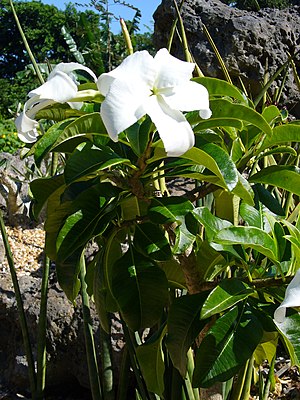Pachypodium decaryi
| Pachypodium decaryi | ||||||||||||
|---|---|---|---|---|---|---|---|---|---|---|---|---|

Pachypodium decaryi |
||||||||||||
| Systematics | ||||||||||||
|
||||||||||||
| Scientific name | ||||||||||||
| Pachypodium decaryi | ||||||||||||
| Poiss. |
Pachypodium decaryi is a plant type from the genus Pachypodium in the family of Hundsgiftgewächse (Apocynaceae).
description
Pachypodium decaryi is a perennial plant with a trunk up to 2 m high , which can reach a diameter of 40 cm at the base. The branches are smooth, unlike other species of the genus has Pachypodium decaryi a very reduced spines on: Just stand on the tips of the branches, the thorns in groups of three, they are together with the foliage leaves dropped. The leaves are 5 to 10 cm long and 3.5 to 5 cm wide. They are elliptically-pointed, have a short petiole and are finely hairy on the underside.
The flowers are in groups of up to ten at the tips of the shoots. They are saucer-shaped, colored white, reach a diameter of 12 cm and a length of 5 to 8 cm. The corolla tube has a diameter of about 6 mm.
The fruits stand upright and are curved from the base, they become 22 cm long and 1 cm in diameter. The seeds become 1 cm in size.
distribution
The species is endemic to the north of Madagascar .
Systematics
The species was first described in 1916 by Henri Louis Poisson .
proof
literature
- DG Rowley: Pachipodium . In: Urs Eggli (Ed.): Illustrated Handbook of Succulent Plants: Dicotyledons . Springer Verlag, 2002, ISBN 978-3-540-41966-2 , p. 13.
Individual evidence
- ^ Bulletin de l'Académie Malgache. Volume 3, pp. 235-236, 1916 online at biodiversitylibrary.org, accessed October 2, 2018.